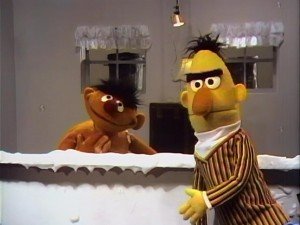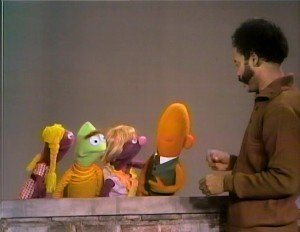Sesame Street Ep #1
Then, we’re back to Ernie, who leads us in a very 60s “Everybody Wash!” dance number, which in turn transitions to a short animated bit that will recur throughout the episode which very cleverly teaches pattern recognition. It’s essentially a bunch of dots in rows, appearing in time to music, and the first few times we see it, it’s always the same pattern. But later on, it starts to change. The last dot will appear late, from the wrong direction, or change colors, or do something disruptive, which cleverly upends our expectations while educating very subtly on pattern recognition.
And next up, we have another counting film, starring the baker who falls with his cakes. This time, it’s of the number 3, and before the baker appears, we see Jim himself juggling 3 balls, and young Brian Henson finding exactly 3 peas on his otherwise empty plate.
Next up, we’re in Gordon and Susan’s apartment for the milk and cookies, which then cuts to the most patience-testing “short” film we’ve seen thus far, a particularly dozy number in which we see where milk comes from, accompanied by real footage from various dairy farms and a Simon and Garfunkel-ish folk number by Joe Raposo that repeats the line “Hey cow, I see you now…” seemingly hundreds of times. For someone I otherwise consider a genius, this…is not his best work, to say the least. For a show that bragged about its quick segments, this one lasts an initially hypnotic, ultimately mind-numbing 6 and 1/2 minutes. Apparently, in later appearances, it was trimmed down for time, a luxury that was not bestowed upon viewers for this first go-round.
A little later on, we meet Orange Oscar, and then see a fun little claymation film about Sam and the Snake and Sissy the Skunk, as well as a short film about various animals in the city that culminates with an afternoon shot of the Twin Towers. That’s followed by a woman named Jennie–who apparently recurred only in Season 1–teaching Sally how to sew, and in the process introducing the concepts of over, around, and through, which is then reasserted by a short film of a bunch of city kids frolicking around a junkyard, playing “Follow the Leader”. This is another segment that would never air on the show today. They crawl through filthy-looking pipes, at one point walk across precariously dangling planks that seem to be part of a construction site, and one kid crawling under them even knocks a paint can full of dirty water onto his head. I almost felt nervous for their safety, and I’m watching it over 40 years later on DVD!
Incidentally, from all of my “and next” sort of comments, you can probably tell that the plotting at this point is still rudimentary. Unlike the test pilot, there is a throughline, namely Sally’s first day on the street, but we’re definitely not yet at the point where an episode would have an actual story. Even some level of narrative, however, increases the momentum significantly from the far more stagnant pilot.
But anyway, next, we have a cartoon starring Alice Braithwaite Goodyshoes, the “smartest girl in the world,” who was also a recurring thing in Season 1. Here she claims to be great at understanding the concept of “through,” but then gets covered in green paint when she sticks her head under the bottom of a tube that she’d just poured the paint into, so I have my doubts. And that’s followed by a scene in which Gordon interacts with a group of blank Anything Muppets, each of whom decides to take on the role of a different member of a family, asking Gordon to apply various eyes, ears, and noses to them in order to turn them into the people they want to be for the day.
It’s a sweet and shockingly progressive, ahead-of-its-time sketch, in that the implication is that any of them could be anyone on any day. The character who chooses to be a little girl today could be the little boy tomorrow, or even the dad. Also, rather funnily, all of the male characters here are bald, so I’m not sure if Gordon was making any sort of particular statement. Perhaps he was unintentionally foreshadowing his own future baldness, in the form of Roscoe Orman, who would play the role longest. Okay, probably not. Also, it’s neat to see a concept that Jim first introduced in The Muppets on Puppets, of taking the audience behind the curtain to speak and showing them how a puppet is made, used so directly on Sesame Street. It’s incredible how the moment the eyes and nose are attached, we fully accept the illusion, even though we know they’re all just props attached by double-sided tape.
This cuts to an otherwise ordinary little scene at Mr. Hooper’s store in which Susan is picking up some milk, that is only significant here because it features something that became a genuine rarity later: Ernie sitting in the shop, drinking his own glass of milk and saying “My compliments to the cow!” in a funny callback to that interminable milk film. As I mentioned in the previous post, in later years, Bert and Ernie were basically always only in their apartment, because that allowed Jim and Frank to shoot the Bert and Ernie scenes for the entire year in a row in between seasons of The Muppet Show and other projects.
And a little later we see Bert and Ernie both together on the street, after a “2” cartoon airs, Bert trying to calm down a sobbing Ernie, who can’t stop crying because he is overwhelmed with emotion over how much he loves the number 2. Finally, once Bert gets him back on track and announces an “E” film is coming next, Ernie erupts into tears again, because naturally, it’s his favorite letter, it being the first in his own name, this scene underlining another aspect of the Ernie/Bert dynamic, namely Ernie’s broad, heart-on-his-sleeve emotions and Bert’s buttoned-down propriety.
The following “E” cartoon, by this way, is cleverly not just about words that start with “e” as most of the other toons have been when introducing a letter but rather the sound of “e,” with many of the words actually containing the “e” sound in the middle, not the beginning. And in classic Sesame Street style, the cartoon doesn’t explain this but just presents its point through repetition, trusting the kids to get it for themselves, or to pick up on it eventually. Like the dot cartoons, this shift also keeps kids on their feet, not always getting the exact lesson they might expect. And as with the dots, they may not even realize they are lessons. The subtlety is key to the entertainment factor.



